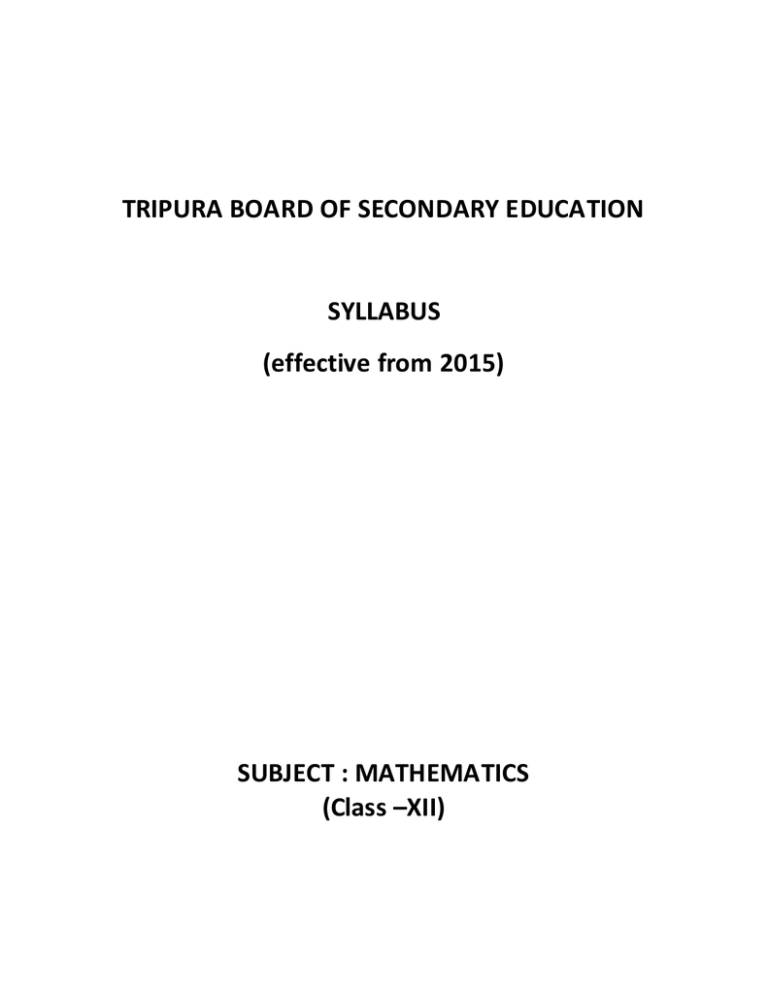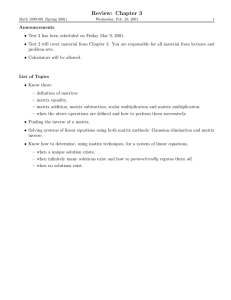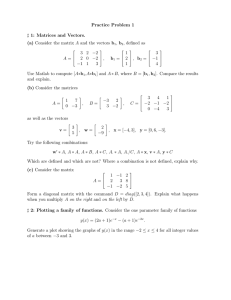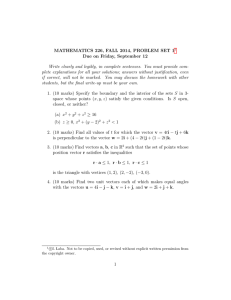Mathematics - School Education Department
advertisement

TRIPURA BOARD OF SECONDARY EDUCATION SYLLABUS (effective from 2015) SUBJECT : MATHEMATICS (Class –XII) Total Page- 08 MATHEMATICS COURSE STRUCTURE Class XII One Paper Unit Time: 3 Hours Title Marks:100 Marks I. Relations and functions 10 II. Algebra 12 III. Calculus 40 IV. Vectors and Three - Dimensional Geometry 18 V. Linear Programming 08 VI. Probability 12 Total 100 Page - 1 UNIT I. RELATIONS AND FUNCTIONS 1. Relations and functions : (10) Periods Types of relations, reflexive, symmetric, antisymmetric, transitive and equivalence relations. One-one, onto functions, One-one onto functions composite functions, Concept of exponential and Logarithmic functions, inverse of a function. Binary operations and simple properties. 2. Inverse Trigonometric Functions : (12) Periods Definition, range, domain, principal value branches, Graphs of inverse trigonometric functions, Elementary properties of inverse trigonometric functions. UNIT II. ALGEBRA 1. Matrices : (18) Periods Concept, notation, order, equality, types of matrices upto 3 rd order: Column matrix, Row matrix, Square Matrix, Diagonal matrix, Scalar matrix, Identity matrix, Zero matrix, Transpose of a matrix, Orthogonal matrix, Symmetric and skew symmetric matrices. Addition, multiplication and scalar multiplication of matrices, simple properties of addition, multiplication and scalar multiplication. Non commutativity of multiplication of matrices and existence of non-zero matrices whose product is the zero matrix (restricted to square matrices of order 2). Concept of elementary row and column operations. Invertible matrices and proof of the uniqueness of inverse, if it exists. (Here all matrices will have real entries). Page - 2 2. Determinant : Determinant of a square matrix (up to 3 x 3 matrices), properties of determinants, minors, cofactors and application of applications of determinants in finding the area of a triangle. Symmetric and skew symmetric determinants and their properties. Adjoint and inverse of a square matrix. Consistency, inconsistency and number of solutions of system of linear equations by examples, solving system of linear equations in two or three variables (having unique solutions) using inverse of a matrix. Cramer’s Rule and its applications. UNIT III. CALCULUS 1. Continuity and Differentiability : (18) Periods Continuity and differentiability, derivative of composite functions, chain rule, derivates of inverse trigonometric functions, derivate of implicit functions, concept of exponential and logarithmic functions to be base e. Logarithmic functions as inverse of exponential functions. x log( 1 x ) , lim e 1 x 0 x 0 x x lim 1/ x, lim 1/ x, lim (1 x )1/ x , lim x 0 x x 0 Derivatives of logarithmic and exponential functions. Logarithmic differentiation, derivative of functions expressed in parametric forms . Second order derivatives. Rolle’s Theorem and Lagranges’s Mean value theorems (without proof) and their geometric interpretation an simple applications. 2. Applications of Derivatives : (10) Periods Applications of derivatives : Rate of change, increasing / decreasing functions, tangents and normals, approximation, maxima and minima (first derivative test Page - 3 motivated geometrically and second derivative test given as a provable tool). Simple problems (that illustrate basic principles and understanding of the subject as well as real-life situations). 3. Integrals : (20) Periods Integration as inverse process of differentiation. Integration of a variety of functions by substitution, by partial fractions and by parts. Only simple integrals of the following type to be evaluated. ∫x dx±a , ∫√x dx±a , ∫ 2 2 ∫√ dx 2 2 , ∫ √px ++ q 2 , a x bx+c px + q dx , 2 √ax +bx+c 2 dx 2 a x +bx +c ∫ ∫√ax +bx+c dx , √a x2 + bx +c ∫√a ± x 2 , 2 dx , dx ∫√ a ± x 2 ∫(px+q) √ax +bx+c 2 dx , ∫√axax +b+bx+c , dx + msinx) ∫(lcosx pcosx +qsinx +c 2 2 dx dx dx dx ∫a+bcosx ∫ , a+bsinx , ∫e sinbxdx, ∫e cosbxdx , ∫e [f(x) + f(m)] dx ax ax x Definite integrals as a limit of a sum. Fundamental Theorem of Calculus (without proof). Basic properties of definite integrals and evaluation of definite integrals. Page - 4 4. Application of the Integrals : (10) Periods Applications in finding the area bounded under simple curves, especially lines, areas of circles/ parabolas / ellipses (in standard form only). Area under the curve y = sin x, y = cos x, area between the two above said curves (the region should be clearly identifiable). 5. Differential Equations : (10) Periods Definitions, order and degree, general and particular solutions of a differential equation. Formation of different equation whose general solution is given. Solution of differential equations by method of specification of variables, homogeneous differential equations of first order and first degree solutions of linear differential equation of the type: dy dx py q, where p and q are functions of x only dx px q, where p and q are functions of y dy UNIT IV. VECTORS AND THREE-DIMENSIONAL GEOMETRY 1. Vectors : (12) Periods Vectors and scalars, magnitude and direction of a vector. Direction cosines/ratios of vectors. Type of vectors (equal, unit, zero, parallel and collinear, co planner, dependent and independent vectors). Position -vectors of a point, negative of a vector, components of a vector, addition of vectors, multiplication of a vector by a Page - 5 scalar, position vector of a point dividing a line segment in a given ratio. Triangle and parallelogram law of vectors, simple application. Scalar (dot) product of vectors, projection of a vector on a line. Vector (cross) product of vectors. Scalar triple product. Geometrical representation of product of vectors. Simple application of dot, cross and scalar triplet product. 2. Three-dimensional Geometry : (12) Periods Direction cosines / ratios of a line joining two points. Orthogonal projection of a line segment on a straight line. Cartesian and vector equation of a line, coplanar and skew lines, shortest distance between two lines cartesian and vector equation of a plane in Cartesian and vector forms. Angle between (i) two lines, (ii) two planes, (iii) a line and a plane. Distance of a line and plane from a point. Condition of coplanarity of two straight lines, condition for a straight line to lie on a plain and simple applications. UNIT V. LINEAR PROGRAMMING 1. Linear Programming : (12) Periods Introduction, definition of related terminology such as constraints, objective function, optimization, different types of linear programming (L.P:) problems, mathematical formulation of L.P. problems, (diet problem, manufacturing problem, transportation problem, investment problem), graphical method of solution for problems in two variables. feasible and infeasible regions, feasible and infeasible solutions, optimal feasible solutions (upto three non-trivial constraints). Page - 6 UNIT VI. PROBABILITY 1. Probability : (18) Periods Multiplication theorem on probability, Conditional probability, dependant and independent events, total probability, Baye’s theorem, Random variable and its probability distribution, mean and variance of random variable. Repeated independent (Bernoulli) trials and Binomial distribution its mean and its variance. Page - 7 MATHEMATICS CLASS XII UNITWISE QUESTION TYPES WITH MARKS DISTRIBUTION Unit Title Total MCQ/VSA SA LA 1 Mark 4 marks 6 marks Marks a) Relations and functions 1 1 - 5 b) Inverse Trigonometric functions 1 1 - 5 a)Matrix 1 - 1 7 b) Determinants 1 1 - 5 a) Continuity and Differentiability 2 1 - 6 b) Applications of Derivatives 1 1 1 11 c) Integrals 1 2 - 9 d) Application of Integrals 1 - 1 7 e) Differential Equations 1 - 1 7 a) Vectors 2 1 - 6 IV b) three - Dimensional Geometry 2 1 1 12 V Linear Programming 2 - 1 8 VI Probability 2 1 1 12 8+10=18 10 7 I II III Total no of questions Total Marks 100 N.B. 1. All questions are compulsory. 2. There is no overall choice in the paper. However internal choice is provided in 2 questions of 4 marks each and 3 questions of 6 marks each. 3. In SA and LA type of questions total marks may be subdivided into different parts, if necessary. 4. Use of simple calculators is permitted. Page - 8





